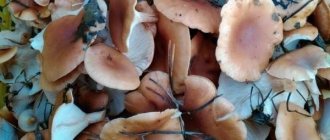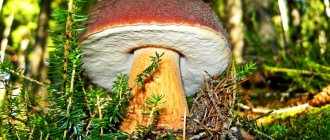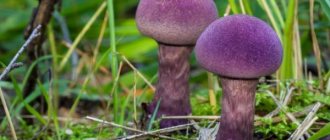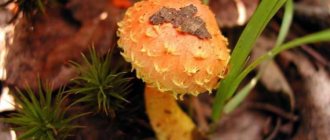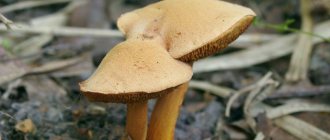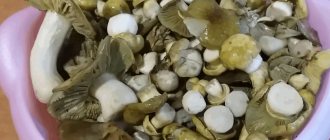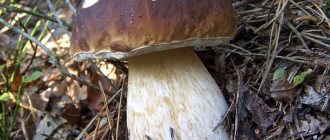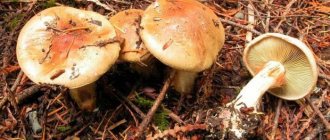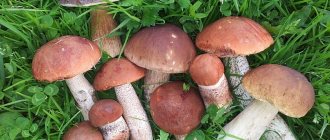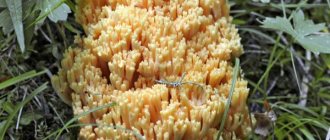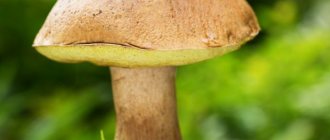Description of the mushroom
The name of the genus is govorushki, the Ryadkov family. The mushroom also has other names: Smoky row, Smoky-gray Govorushka or simply Smoky Govorushka. Lat. name - Clitocybe nebularis. Prices 1 per kg fluctuate around 3–4 dollars.
A little history
The first mushroom was described by French botanist Pierre Buillard in 1857. In his work, he described the entire genus of the Ryadkovs, where each mushroom was given a distinctive characteristic.
hat
The cap is large, fleshy. The average diameter is from 5 to 15 cm. Small mushrooms have a spherical cap, which expands over time and forms a tubercle. The edges are slightly turned up and can remain in this form until the end of the entire life cycle. The color is ashen, sometimes grayish or yellowish. The middle of the cap has a richer color than the edges.
Hymenophore
The hymenophore is one of the organs of the fruiting body, located on the inside of the mushroom cap.
At the beginning of the talker's life cycle, the plates are light, but later turn yellow. They are located often, falling slightly onto the leg.
Pulp on the cut
Early mushrooms have dense, thick, white flesh. As it grows it becomes somewhat grey, porous and loose. It emits a strong odor, especially when cooked. It smells specific - fruits and flowers.
Leg
The leg is quite thick, 1-3 cm in diameter. Wider at the base, grows up to 8 cm in height. Light, sometimes club-shaped.
Smoky talker (Clitocybe nebularis)
Smoky row
Smoky talker or smoky row (lat. Clitocybe nebularis) is a mushroom of the genus of talkers of the Ryadovkov family. Cap: Large, fleshy, 5-15 cm in diameter, initially hemispherical, spread out with age, sometimes depressed.
In youth, the edge of the cap is noticeably turned up; this “tucked-in” appearance is often preserved even in a prostrate form, making the appearance of the mushroom very characteristic. Color - ashy, sometimes with a yellowish tint; the edges are lighter than the central area. The pulp is thick, white, and becomes loose with age. The smell is very characteristic, fruity-floral (very noticeable during cooking). Lamellae: Initially white, then yellowish, frequent, slightly descending.
Spore Powder: Whitish.
Leg: Thick, widening towards the base, often club-shaped, fleshy, fleshed out with age, light in color. Height 4-8 cm, thickness 1-3 cm.
Distribution: Smoky talker grows from late summer to late autumn (especially abundantly from mid-September to the first ten days of October, or even later) in spruce and mixed forests (preferring, apparently, to form mycorrhiza with spruce), as well as on the edges, in gardens etc. Often appears in very large groups, forming rings and rows.
Similar species: Many rowers and entolomas are similar to the smoky talker, which, however, can be unmistakably identified by its characteristic “floral” smell. If the smell is not so pronounced (which depends on the growing conditions), a distinctive feature of Clitocybe nebularis can be considered a certain “cottoniness” of the pulp in adult mushrooms, which is not characteristic of either rowers or entolomas. Of course, these signs are highly inaccurate, but once you get acquainted with the smoky row, it’s easy to learn to distinguish it from all other mushrooms without any signs. Intuitively. On the other hand, without knowing the mushroom well, you can confuse it with the club-footed talker (Clitocybe clavipes). The smell will put everything in its place.
Edibility: Smoky row - A good edible mushroom, according to some sources - conditionally edible (to avoid misunderstandings, it is better to boil the mushroom, do not use the broth for food). It boils down surprisingly well - perhaps a champion in boiling. Some sources, including Vishnevsky, talk about the toxicity of this mushroom, arguing that this is some kind of heresy (allegedly, “it causes shortness of breath and sweating”). I don't think this should be taken seriously. Another thing is that the peculiar taste and especially the smell of the smoky row is not to everyone’s liking.
Video about the mushroom Govorushka smoky:
Notes: Smoky talker is a mushroom that can make you fall in love at first sight. Large, plump fruiting bodies; noble rough hats; solid tuber legs. And the scale.
This mushroom knows how to surprise. The pan was loaded with a huge heap, ten minutes - and there were barely mushrooms at the bottom. So it boiled down. Or did everyone smell it? The famous “floral aroma” is most pronounced during cooking - especially if the smoky talkers are cooked separately from other mushrooms, on their own. Can you imagine our amazement when the whole hut was suddenly filled with the aroma of rose oil? We didn’t immediately think about mushrooms - no one warned us that it should be like this.
And what big worms there are in these talkers. I confess honestly: I have never seen such healthy worms before. That is, of course, individually - it didn’t matter, but as a system, when the cap of each overripe mushroom is filled with huge worms... no, it was a big surprise.
Clitocybe nebularis is an interesting mushroom with a complex character. Previously, for some reason, I ignored both rows and talkers, considering them to be spineless European, “universal” mushrooms. Only now is the full depth of this misconception beginning to dawn on me...
Growing at home and in the country
Gray rower can be grown in your summer cottage using mycelium. It should be purchased at a specialty store. We bring to your attention another method that gives more guarantees that your work will not be in vain.
Note! Planting is done in the fall, at a temperature not lower than 15°C.
Growing method:
- Choose a place under a tree, make a hole in the ground (10-15 cm).
- Dig up a mycelium in the forest. Do this carefully so that the forest soil remains on the roots.
- Place in the hole, carefully cover with soil.
- When you notice that new mycelium is appearing, dig the bed down a little with soil.
- Sprinkle the mycelium with soil after each harvest.
False doubles
Many rows look like talkers. Its main difference is its floral aroma. The grayish-yellow cap and the somewhat cottony, delicate consistency of the pulp will also help to recognize the edible mushroom. Pay attention to the photo:
Gray talker
Below is a photograph showing two species similar to the smoky talker. These are Ryadovka soap and Talkorushka blavonogaya. Both mushrooms are edible, but there is nothing similar in taste.
Violet Talker also exists in nature. It can be distinguished by the shade of the mushroom body (lilac predominates). The taste is excellent, so even if you confuse two talkers with each other, you will not harm your health.
The club-footed talker
Soap row
There is no poisonous twin for the smoky row. The table describes the similarities and differences:
| Gray | Purple | |
| hat | 5-15 cm | 6-15 (20) cm |
| Cap shape | spherical, prostrate | spherical, wavy-curved |
| Cap color | Ashy (with yellowness) | Bright purple; later - ocher |
| Pulp | White | Light violet, ocher-cream |
| Leg | 4-8 cm | 4-8 (12 cm) |
| Smell | Fruit | Anisic |
Evaluation of taste qualities, medicinal properties, benefits and possible harm
Gray talker is an edible mushroom. It can be prepared in various ways, with the only caveat: only young mushrooms are eaten. The aroma is not mushroom, more like the smell of flowers, champagne, fruits. The taste is delicate.
The smoky plant contains a powerful antimicrobial substance called nebularin. However, the mushroom should not be consumed in large quantities, because this may cause poisoning. The reason lies in the fact that talkers tend to accumulate heavy metals.
Remember! Gray rower should be collected exclusively at the edge of the forest. Beware of collecting near highways.
Advantages and disadvantages of gray talker
Gray (smoky) talker is found in the forest until late autumn, often in significant quantities.
The mushroom has very characteristic features (appearance, smell). It has no resemblance to poisonous and inedible mushrooms.
Gray talker needs preliminary boiling with the obligatory draining of the broth. When boiled, the smell intensifies, becoming unpleasant. This can make the process of cooking the mushroom uncomfortable.
And also the gray talker - a medicinal mushroom. The antibiotic nebularin, named after the species name of the fungus, was found in fresh fruiting bodies.
Nebularin suppresses the development of Koch's bacillus (the causative agent of tuberculosis), as well as pathogenic fungi. It is probably the presence of nebularin that makes it necessary to boil these mushrooms for consumption.
Gray talker also has antitumor activity.
Interested in the medicinal properties of mushrooms? I can recommend the excellent book “Medicinal Mushrooms” by Moscow mycologist Mikhail Vishnevsky.
But collecting gray talker near highways or industrial zones is simply dangerous. The fungus actively accumulates heavy metals.
However, this applies to any mushrooms.
Cooking recipes
If you are going to cook a delicious dish from the row, then keep in mind: the mushroom boils down a lot. For example, to make pickles, the talker needs to be boiled, so from 1 kg of collected mushrooms you will get only 1 liter jar.
Remember! The gray row is susceptible to pests. Before cooking, carefully inspect the fruit for worms and bugs.
Primary processing
Before cooking, the fruits should be cleared of forest debris with a knife and washed. The row requires pre-cooking for 15-20 minutes.
Cooking
You need to cook talkers before marinating and salting. You can use boiled mushrooms as a separate dish.
Ingredients:
- 1 kg of gray row;
- 1 liter of water for cooking;
- 1 tbsp. l. salt;
- 0.25 tsp citric acid;
- 5 black peppercorns;
- 1 bay leaf;
- 2 pcs. carnations.
How to cook:
- Clean the collected rows from forest dirt with a knife. Remove damage and darkened areas from the fruit. You can peel off the top layer of the cap.
- Wash the mushrooms thoroughly under running water.
- Pour cold water into an enamel pan, add salt and citric acid. Bring the marinade to a boil.
- Place a row in the pan and close the lid. Time it for 10 minutes.
- Add black pepper, bay leaf, cloves. Cook for another 10 minutes.
- Drain the water and cool. If you plan to serve the rows on the table and do not plan further processing, supplement the dish with sour cream and finely chopped fresh herbs.
Pickling
To prepare this type of preservation you will need the following ingredients:
- 1 kg of rows;
- 2 tbsp. l. 9% vinegar;
- 1.5 tbsp. l. Sahara;
- 10 pieces. peppercorns;
- 1 tbsp. l. salt;
- 2 bay leaves;
- 4 clove inflorescences.
Step-by-step preparation:
- Sort the fruits and wash them. Large mushrooms are cut into slices, small ones can be left as is.
- Place the rows in a saucepan, fill with water. Cook until they sink to the bottom (at least 20 minutes). Foam will form during the cooking process. Remove it with a slotted spoon so as not to spoil the marinade.
- Add vinegar and turn off heat.
- Pour the contents of the pan into sterilized jars and seal.
- Turn the containers upside down and wait until they cool completely. The pickled mushroom is placed in the cellar and enjoyed with pickling all winter.
Freezing
Before freezing the rows, they must be thoroughly cleaned and boiled. The process consists of the following stages:
- Boil the washed and peeled rows (see recipe above).
- Place the fruits in a colander, let them drain, and then dry them on a napkin or towel.
- When the rows have cooled and dried, place them in a plastic container or plastic bag.
- Store the preparation in the freezer.
Frying
You can add a special mushroom taste and aroma to your favorite fried potatoes or other side dishes using the following dish.
Products:
- 500 g mushrooms;
- 2 liters of water;
- 2 tbsp. l. sunflower oil;
- 1 tbsp. l. salt.
Preparation:
- It is necessary to clean the row of dirt. Cut off the edges of the stem and wash the talkers.
- Place the mushrooms in a saucepan and cover with water. Add some salt.
- Cook the rows for 20 minutes, periodically removing the foam.
- Drain the mushrooms in a colander.
- Heat oil in a frying pan. Put talkers in it. Fry for 10 minutes over medium heat, stirring.
- Lightly salt the mushrooms, fry for another two minutes and turn off the gas.
Pickling
It is best to pickle talkers in the fall, because autumn fruiting bodies are denser. Opt for small young mushrooms. The smaller the row, the faster you can salt them and use them for food.
Ingredients:
- 1 kg of mushrooms;
- 2.5 liters of water;
- 75 g salt;
- 3 bay leaves;
- 10 pieces. black and allspice peas;
- 5 pieces. carnations.
How to pickle mushrooms:
- Pour water into a saucepan and place on fire. Add all the above spices and bring to a boil.
- Clean the talkers, wash them. Send into rushing water.
- Reduce heat. Cover the pan tightly with a lid and boil the fruits for 50 minutes.
- Place boiled mushrooms in pre-sterilized jars, add brine from the pan.
- When the jars have cooled, cover them with plastic lids and place them in a cool place.
- The rows can be eaten 35-40 days after salting. Properly salted mushrooms retain their elastic structure and are crunchy.
Drying
It is not advisable to dry the rows - the mushrooms will be tough and tasteless. It is better to make salting for the winter.
Application
In cooking
The caps of young specimens are used in cooking. First, they are pre-cooked and only then used in the preparation of other dishes. When cooking, it is important to take into account that this type boils down very strongly, about 5 times.
Vinaigrette with pickled talkers
For the salad you will need:
- pickled mushrooms – 150 g;
- potatoes – 1-2 pcs.;
- carrots – 1 pc.;
- beets – 1 pc.;
- sauerkraut – 20-30 g;
- onion – ½;
- sunflower oil – 20 g;
- salt - to taste.
All ingredients are cleaned, cut into cubes, mixed with talkers, cabbage, salt and butter are added. The salad is ready to eat; you can garnish it with small whole pickled mushrooms.
Talker caviar
For caviar you need:
- pickled mushrooms – 180 g;
- onion – 1 pc.;
- vegetable oil – 30 g;
- pepper, salt - to taste.
The onion is cut and fried, the mushrooms are finely chopped and mixed with the onion, they are salted, peppered, and mixed. Caviar is eaten on its own or used as a side dish.
In medicine
The smoky talker mushroom is used in the manufacture of medicines:
- clitobicin;
- nebularin;
- Diathrein and others.
What is the talker used for:
- treatment of tuberculosis, epilepsy;
- restoration, cleansing of the body;
- removal of toxins, heavy metal salts;
- antibacterial effect;
- healing of wounds.
Growing methods
The smoky row is grown at home. The mycelium is sown from late spring until autumn. Holes are prepared near tree trunks at a depth of 22 cm, filled with prepared soil and the mycelium is evenly placed on top of them. Next, a small layer of soil is poured and compacted. The plantings are covered with a layer of leaves, branches, and moss. The holes are watered regularly. When watering, it is important to avoid both excess and lack of moisture: do not make a swamp, but do not leave the surface dry. The first harvest will be ready after a year; talkers bear fruit under favorable conditions for 3-5 years. Productivity – 17 mushrooms per season.
Gray talker is grown at any time of the year indoors in boxes.
